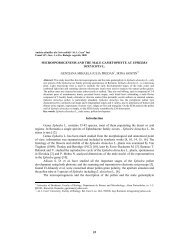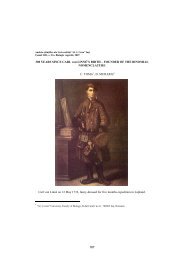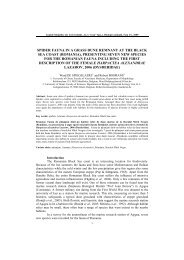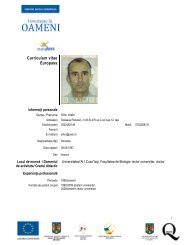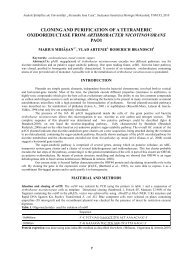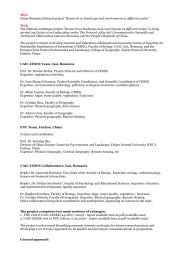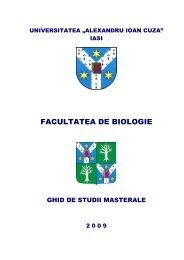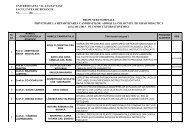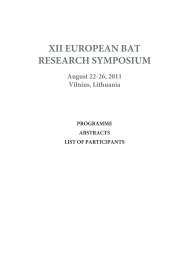COMITETUL DE REDACŢIE - Facultatea de Biologie
COMITETUL DE REDACŢIE - Facultatea de Biologie
COMITETUL DE REDACŢIE - Facultatea de Biologie
Create successful ePaper yourself
Turn your PDF publications into a flip-book with our unique Google optimized e-Paper software.
Analele Ştiinţifice ale Universităţii „AL. I. CUZA” Iaşi, s. <strong>Biologie</strong> animală, Tom LII, 2006<br />
SILIŞTIOARA MARSH – POTENTIAL IMPORTANT BIRD AREA<br />
NARCISA ORZAŢĂ<br />
University of Craiova, Str. Al. I. Cuza 13, 200585 Craiova, Romania;<br />
e-mail: narcisaorzata@yahoo.com<br />
Abstract. The Siliştioara Marsh, located on the outskirts of Corabia, on the Danube bor<strong>de</strong>r, is one of the few<br />
marshes remaining in the Danube valley between the Rivers Jiu and Olt. The marsh is an important resting place,<br />
visited by numerous passage visitor bird species and also by bird species that nest here or in the adjacent areas.<br />
The vast majority of these are inclu<strong>de</strong>d in the local and global protection and conservation plans. The purpose of<br />
this paper is to present the area’s bird fauna spectrum, in or<strong>de</strong>r to <strong>de</strong>clare it Important Bird Area (I.B.A).<br />
Keywords: Siliştioara Marsh, Danube Meadow, Important Bird Area, bird fauna<br />
Rezumat. Balta Siliştioara – potenţială Arie <strong>de</strong> Importanţă Avifaunistică. Balta Siliştioara, situaţă în<br />
imediata vecinătate a localităţii Corabia, pe malul Dunării, este una dintre ultimele bălţi naturale existente în<br />
lungul văii Dunării între văile râurilor Jiu şi Olt. Adăpostind un număr total <strong>de</strong> cel puţin 106 specii <strong>de</strong> păsări<br />
inventariate până în present, balta reprezintă un important loc <strong>de</strong> refugiu pentru păsări fiind vizitată <strong>de</strong><br />
numeroase specii în pasaj; totodată, balta Siliştioara constituie arie <strong>de</strong> cuibărit pentru păsări acavtice şi<br />
semiacvatice, majoritatea fiind incluse în anexele unor convenţii internaţionale şi legi prvind protecţia speciilor<br />
şi a habitatelor în care acestea trăiesc. Dintre speciile <strong>de</strong> păsări înregistrate <strong>de</strong> noi, 86 constituie criteriu pentru<br />
<strong>de</strong>semnarea Ariilor <strong>de</strong> Importanţă Avifaunistică (A.I.A.).<br />
Cuvinte cheie: Balta Siliştioara, lunca Dunării, Arie <strong>de</strong> Importanţă Avifaunistică, avifaună<br />
Introduction<br />
Siliştioara Marsh is perhaps the only marsh left in the Danube meadow between<br />
the Rivers Jiu and Olt, after there were achieved important hydrotechnics arrangements<br />
and improvement actions for the <strong>de</strong>crease of the flood risk and also for the enlargement of<br />
the agricultural areas, in the 60s and 70s.<br />
The marsh is located on the outskirts of the town of Corabia, on the Danube<br />
banks, right below the first terrace, at about 100-300 meters from the road. Although it<br />
isn't a large body of water, it continues eastwards (in Gârcov village) in a stretch of 150-<br />
200 m of reed and club rush (100 hectares). The marsh has its own springs, but the water<br />
level is influenced by the Danube, as well as by rainfall. Water <strong>de</strong>pth is of about 0.5 m.<br />
The southern part of the marsh consists of pastures, which are partially wet, and are used<br />
by local people for grazing. There is no protection dyke in the area, and the tree cordon is<br />
a bit further away. In front of the marsh, on the Danube, there is the Băloi Islet (200 ha),<br />
covered by riversi<strong>de</strong> coppices of willow, acacia and poplar trees. Around the marsh,<br />
especially on the southern bank, but also in the marsh itself, there is rich paludous<br />
vegetation.<br />
The marsh has not been studied before 2002 (Orzaţă, 2002) and the bird fauna<br />
observation have been done during the period 2002-2005. These allow us to conclu<strong>de</strong> that<br />
the marsh and its neighbouring areas are populated by numerous bird species, especially<br />
during migration periods and during the nesting periods, too.<br />
Material and Methods<br />
Ornithological observations were taken during 2002-2003, covering the all<br />
phenological aspects. The methods used were the transect method and the observation<br />
from fixed point, the i<strong>de</strong>ntification of the birds being ma<strong>de</strong> by direct observations with the<br />
- 219 -
Narcisa Orzaţă<br />
10x50 binoculars. Transects and observation points were established from the first visits<br />
and were kept for the entire period of study. The census of bird populations was done by<br />
direct counting of all observed individuals.<br />
Results and Discussion<br />
This paper analyzes the bird fauna spectrum of the Siliştioara Marsh from the<br />
Danube Meadow, in Olt County, and the status of the i<strong>de</strong>ntified species, with the purpose<br />
of including this area on the list of Romanian Important Bird Areas.<br />
During the four years of observations (Orzaţă, 2002, 2002a, 2003, 2003a, 2005,<br />
2005a), 106 species have been i<strong>de</strong>ntified in this area (Table 1), belonging to 12 or<strong>de</strong>rs and<br />
34 families. Aquatic and semi-aquatic bird species of the Ciconiiformes Or<strong>de</strong>r have a<br />
strong presence (12 species), as do those of the Anseriformes Or<strong>de</strong>r (15 species) and<br />
Charadriiformes Or<strong>de</strong>r (26 species). Best represented are birds from the Passeriformes<br />
Or<strong>de</strong>r with 31 species (29.24% of whole recor<strong>de</strong>d bird fauna), belonging to 10 families.<br />
It is certain that insi<strong>de</strong> or nearby the marsh (especially on the Băloi Islet), the<br />
following bird species are breeding: the Mallard Duck (Anas platyrhynchos), the<br />
Garganey (Anas querquedula), the Grey Heron (Ar<strong>de</strong>a cinerea), the Little Bittern<br />
(Ixobrychus minutus), the Night Heron (Nycticorax nycticorax), the Eurasian Coot (Fulica<br />
atra), the Common Moorhen (Gallinula chloropus), the Lapwing (Vanellus vanellus), the<br />
Black-winged Stilt (Himantopus himantopus), the Little Tern (Sterna albifrons), warbler<br />
species (Acrocephalus sp.), the Savi' s Warbler (Locustella luscinioi<strong>de</strong>s), the European<br />
Bee-eater (Merops apiaster), but the number of breeding pairs is not large. One of the<br />
possible causes is the location of the marsh in the vicinity of the town of Corabia (the<br />
Siliştioara neighbourhood). In the area, the birds are permanently confronted with the<br />
pressure of several perturbing factors: fishing, grazing, reed burning and harvesting, and<br />
the presence of domestic animals. Aquatic bird species react differently by behavioural<br />
changes of their life regime: leaving the marshes area, renouncing breeding in the<br />
perimeter of a particular marsh, reducing their activities to certain parts of the aquatic<br />
basin.<br />
During summer time numerous birds have been observed, but the majority do not<br />
breed there: the Great Cormorant (Phalacrocorax carbo), the Purple Heron (Ar<strong>de</strong>a<br />
purpurea), the Eurasian Spoonbill (Platalea leucorodia), the Little Egret (Egretta<br />
garzetta), the Mute Swan (Cygnus olor), terns and seagull species.<br />
During spring and autumn, have been noted the presence of duck species (Anas<br />
penelope, Anas clypeata, Anas acuta), shorebirds (Tringa sp., Numenius arquata, Calidris<br />
sp., Gallinago gallinago), this area being an important resting place for these species<br />
during migration period.<br />
We recor<strong>de</strong>d 86 bird species that represent IBA criteria using to i<strong>de</strong>ntify<br />
Important Bird’ Area (81.13% from the whole bird fauna). These species belong to the<br />
following IBA criteria (table 1):<br />
A1 – 4 species of global conservation concern (4.65%): Phalacrocorax<br />
pygmaeus, Pelecanus crispus, Anser erythropus, Aythya nyroca. Its entire have been<br />
observed while passing in the area. Pelecanus crispus became a constant presence in the<br />
area during the last years (30.03.2002 – a single individual; 18.12.2003 – single<br />
individual; February 2004 – maximum 31 individuals; 27-28.09.2005 – 13 individuals).<br />
Phalocrocorax pygmaeus was noted during passage period, with few numbers. Aythya<br />
nyroca could have been breeding in the area during the summer of 2003.<br />
A3 – 5 biome-restricted species (5.81%): Anser albifrons, Calidris temminckii,<br />
Tringa erytropus, Tringa nebularia, Fringilla montifringilla. These birds pass through<br />
there, finding optimal conditions for feeding and resting. Anser albifrons was observed<br />
only once (2 individuals) on March 9 th 2002. The shorebird species (Calidris sp. and<br />
- 220 -
Analele Ştiinţifice ale Universităţii „AL. I. CUZA” Iaşi, s. <strong>Biologie</strong> animală, Tom LII, 2006<br />
Tringa sp.) appear during passage in numbers of tens of individuals. Fringilla<br />
montifringilla was observed in the winter of 2004-2005.<br />
A4/B1 – 60 gregarious species (69.77%) are represented by aquatic and semiaquatic<br />
species (Phalacrocorax carbo sinensis, Pelecanus onocrotalus, Ar<strong>de</strong>a cinerea,<br />
Egretta alba, E. garzetta, Ciconia nigra, Plegadis falcinellus, Platalea leucorodia, species<br />
of the Anseriformes, Gruiformes and Charadriiformes Or<strong>de</strong>rs), or connected to aquatic<br />
environments (Riparia riparia, Merops apiaster), as well as species of raptors<br />
(Falconiformes Or<strong>de</strong>r). The Great Cormorant (Phalocrocorax carbo sinensis) does not<br />
breed in the area, but some individuals stop and feed often in the marsh. The Great White<br />
Pelican (Pelecanus onocrotalus) was observed only once, on November 1 st 2003 (two<br />
individuals). Ar<strong>de</strong>a cinerea breeds next to the Egretta garzetta in the marsh forest, staying<br />
and feeding in the area. Egretta alba stays even during winter time (maximum 15<br />
individuals), together with Ar<strong>de</strong>a cinerea. The Glossy Ibis (Plegadis falcinellus) is a<br />
passage species, the largest number of individuals observed being 37, on April 14 th 2005.<br />
The Spoonbill (Platalea leucorodia) was frequently seen in the area, between April and<br />
October 2002, with a peak population of 57 adult and juvenile individuals in July-August<br />
2002, and from March in 2003 until the end of September that year, breeding probably in<br />
the Băloiu Islet and often crossing the Danube into Siliştioara Marsh. In 2004, the<br />
maximal number was recor<strong>de</strong>d on July 15 th 2004. Most of the Anseriformes of this<br />
category are passage species, as breeding species we noticed the Anas platyrhynchos and<br />
Anas querquedula, and like probably breeding species the Anas strepera and Aythya<br />
ferina. The Common Teal (Anas crecca) is a winter visitor, present from autumn time<br />
(October) till spring (March), with effectives about 150-200 individuals. The Common<br />
Coot (Fulica atra) breeds in the Siliştioara Marsh with about 30 pairs. The Common<br />
Moorhen (Gallinula chloropus) is a regular breeding species, but it effective was not<br />
estimated. Like breeding limicoline bird species have been noticed Himantopus<br />
himantopus, Charadrius dubius, Vanellus vanellus and also the Little Tern (Sterna<br />
albifrons), but not in very large numbers (10-20 pairs for each of them), most of the<br />
limicoline birds being passage species in the marsh perimeter.<br />
B2 – 31 species with an unfavourable conservation status in Europe (36.05%).<br />
From these species, the area is a nesting place for Ixobrychus minutus, Ciconia ciconia (7<br />
nests counted in town, two of these in the neighbourhood adjacent to the marsh),<br />
Chlidonias hybridus (observed on the nest in 2004 and 2005, Merops apiaster (its nests<br />
located in the high bank on the left of the marsh), Riparia riparia (in 2002 – 2003, there<br />
was a colony about several hundreds individuals in the Danube bank, which was<br />
<strong>de</strong>stroyed in the following years due the high levels of the river and flooding, only few<br />
nests being reconstructed in the high bank after this moment), Hirundo rustica, Lanius sp.<br />
B3 – 12 species with favourable conservation status in Europe (13.95%) –<br />
aquatic and semi-aquatic species like Aythya ferina, Porzana parva, Recurvirostra<br />
avosetta, and also passerines: Locustella luscinioi<strong>de</strong>s, Acrocephalus schoenobaenus,<br />
Acrocephalus scirpaceus, Corvus monedula, Fringilla montifringilla, Carduelis chloris,<br />
Miliaria calandra, Emberiza citrinella and Emberiza schoeniclus.<br />
By consulting the Red List of Vertebrates in Romania (Botnariuc & Tatole,<br />
2005), it results that 21 of the species i<strong>de</strong>ntified on the Siliştioara Marsh are inclu<strong>de</strong>d on<br />
the list, as vulnerable or endangered species.<br />
The human pressure in the area is <strong>de</strong>termined largely by intensive grazing and<br />
the presence of small size livestock (ducks, geese). Also in the area is practiced individual<br />
fishing, both on the marsh and on the Danube banks. Reed is cut and used in households,<br />
or is even burned down (Orzaţă, 2005).<br />
- 221 -
Narcisa Orzaţă<br />
Table 1. Avifauna of the Siliştioara Marsh (Olt county).<br />
SPECIES RED<br />
IBA CATEGORIES<br />
LIST A1 A3 A4/B1 B2 B3<br />
Phalacrocorax carbo sinensis (L) *<br />
Phalacrocorax pygmaeus (Pall) * * *<br />
Pelecanus onocrotalus(L) * *<br />
Pelecanus crispus (Bruch) * * *<br />
Botaurus stellaris (L) *<br />
Ixobrychus minutus (L) *<br />
Nycticorax nycticorax (L) * * *<br />
Ar<strong>de</strong>ola ralloi<strong>de</strong>s (Scop) * * *<br />
Egretta garzetta (L) * *<br />
Egretta alba (L) * *<br />
Ar<strong>de</strong>a cinerea (L) *<br />
Ar<strong>de</strong>a purpurea (L) * *<br />
Ciconia nigra (L) * *<br />
Ciconia ciconia (L) * * *<br />
Plegadis falcinellus (L) * *<br />
Platalea leucorodia (L) * *<br />
Cygnus olor (Gmel) *<br />
Cygnus cygnus (L) *<br />
Anser albifrons (Scop) * *<br />
Anser erythropus (L) * *<br />
Anser anser (L) *<br />
Tadorna tadorna (L) * *<br />
Anas penelope (L) *<br />
Anas strepera (L) *<br />
Anas crecca (L) *<br />
Anas platyrhynchos (L) *<br />
Anas acuta (L) *<br />
Anas querquedula (L) *<br />
Anas clypeata (L) *<br />
Aythya ferina (L) * *<br />
Aythya nyroca (Gul<strong>de</strong>nst) * * *<br />
Circus aeruginosus (L)<br />
Accipiter nisus (L)<br />
*<br />
Buteo buteo (L) *<br />
Falco tinnunculus (L) * *<br />
Falco subbuteo (L) *<br />
Perdix perdix (L)<br />
Phasianus colchicus (L)<br />
*<br />
Porzana parva (Scop) *<br />
Gallinula chloropus (L) *<br />
Fulica atra (L) *<br />
Haematopus ostralegus (L) * *<br />
Himantopus himantopus (L) * *<br />
Recurvirostra avosetta (L) * * * *<br />
Glareola pratincola (L) * *<br />
Charadrius dubius (Scop) *<br />
Vanellus vanellus(L) *<br />
Calidris temminckii (Leisl) * *<br />
Calidris ferruginea (Pontopp) * *<br />
Philomachus pugnax (L) * *<br />
Gallinago gallinago (L) *<br />
Limosa limosa (L) *<br />
Numenius arquata (L) * *<br />
- 222 -
Analele Ştiinţifice ale Universităţii „AL. I. CUZA” Iaşi, s. <strong>Biologie</strong> animală, Tom LII, 2006<br />
Tringa erytropus (Pall) * *<br />
Tringa totanus (L) * *<br />
Tringa nebularia (Gunn) * *<br />
Tringa ochropus (L) *<br />
Tringa glareola (L) * *<br />
Actitis hypoleucos (L) *<br />
Larus minutus (Pall) * *<br />
Larus ridibundus(L) *<br />
Larus canus (L) * *<br />
Larus argentatus (Pall) *<br />
Sterna hirundo (L) * *<br />
Sterna albifrons (Pall) * *<br />
Chlidonias hybridus (Pall) * *<br />
Chlidonias niger (L) * *<br />
Columba livia domestica<br />
Streptopelia <strong>de</strong>caocto (Friv)<br />
Cuculus canorus (L)<br />
Athene noctua (Scop) *<br />
Alcedo atthis (L) *<br />
Merops apiaster (L) * *<br />
Coracias garrulus (L) *<br />
Upupa epops (L) *<br />
Galerida cristata (L) *<br />
Alauda arvensis (L) *<br />
Riparia riparia (L) * *<br />
Hirundo rustica (L) *<br />
Delichon urbica (L)<br />
Anthus campestris (L) *<br />
Motacilla flava flava (L)<br />
Motacilla flava fel<strong>de</strong>gg<br />
Motacilla alba (L)<br />
Locustella luscinioi<strong>de</strong>s (Savi) *<br />
Locustella naevia (Bodd)<br />
Acrocephalus schoenobaenus (L) *<br />
Acrocephalus scirpaceus (Herm) *<br />
Acrocephalus arundinaceus (L)<br />
Phylloscopus collybita (Vieil)<br />
Lanius collurio (L) *<br />
Lanius minor (Gmel) *<br />
Garrulus glandarius (L)<br />
Pica pica (L)<br />
Corvus monedula (L) *<br />
Corvus frugilegus (L)<br />
Corvus corone cornix (L)<br />
Sturnus vulgaris (L)<br />
Passer domesticus (L)<br />
Passer montanus (L)<br />
Fringilla montifringilla (L) *<br />
Carduelis chloris (L) *<br />
Carduelis carduelis (L)<br />
Miliaria calandra (L) *<br />
Emberiza citrinella (L) *<br />
Emberiza schoeniclus (L) *<br />
TOTAL: 106 21 4 4 60 31 12<br />
- 223 -
Narcisa Orzaţă<br />
Conclusions<br />
Siliştioara Marsh is one of the last marshes remaining in the Danube Meadow<br />
between the Rivers Jiu and Olt, an unprotected area where the human factors influence the<br />
repartition, biology and ecology of birds present there.<br />
The bird fauna of the Siliştioara Marsh is represented by 106 species belonging<br />
to 12 or<strong>de</strong>rs. 86 of the species are representative criteria for i<strong>de</strong>ntifying important bird<br />
areas, which means 81.13% of the whole i<strong>de</strong>ntified bird fauna.<br />
According to the Red List of Vertebrates in Romania, 21 species present here are<br />
inclu<strong>de</strong>d in this list as endangered and vulnerable, both locally as well as globally.<br />
For these reasons, we propose this area to be inclu<strong>de</strong>d or at least consi<strong>de</strong>red for<br />
inclusion on the list of Romanian Important Bird Areas, its bird fauna spectrum being rich<br />
and representative for this purpose.<br />
References<br />
Botnariuc N., Tatole V., 2005. Cartea Roşie a vertebratelor din România. Aca<strong>de</strong>mia Română, Muzeul Naţional<br />
<strong>de</strong> Istorie Naturală Grigore Antipa, Bucureşti.<br />
Orzaţă, N., 2002. Contribuţii la cunoaşterea avifaunei din zona Corabia-Siliştioara. Analele Banatului, s. nouă,<br />
Ştiinţele Naturii, I: 139-146.<br />
Orzaţă, N., 2002a. Contribuţii la cunoaşterea avifaunei din zona Corabia-Siliştioara (II). Oltenia, Studii şi<br />
comunicări, Ştiinţele Naturii, XVIII: 202-206.<br />
Orzaţă, N., 2003. Rare, vulnerable and endangered birds in Danube Meadow between the rivers Jiu and Olt.<br />
Analele Universităţii din Craiova, s. <strong>Biologie</strong>, Horticultură, Tehnologia prelucrării produselor<br />
agricole, VIII(XLIV): 76-79.<br />
Orzaţă, N., 2003a. Pasările acvatice din Lunca Dunării dintre Jiu şi Olt. Oltenia, Studii şi comunicări, Ştiinţele<br />
Naturii, XIX: 202-206.<br />
Orzaţă N., 2005. Actual Anthropic Influences and Alterations in the Avifauna Caused by Disappearance of<br />
Natural Wet Areas of the Danube Meadow. Analele Universităţii din Craiova, s. <strong>Biologie</strong>,<br />
Horticultură, Tehnologia prelucrării produselor agricole, X(XLVI): 87-94.<br />
Orzaţă N., 2005a. Starea actuală a avifaunei din Lunca Dunării dintre Jiu şi Olt. Oltenia, Studii şi comunicări,<br />
Ştiinţele Naturii, XXI: 187-192.<br />
***, 1995. Buletin A.I.A. Buletin informativ asupra ariilor <strong>de</strong> importanţă avifaunistică din România, 2.<br />
- 224 -



